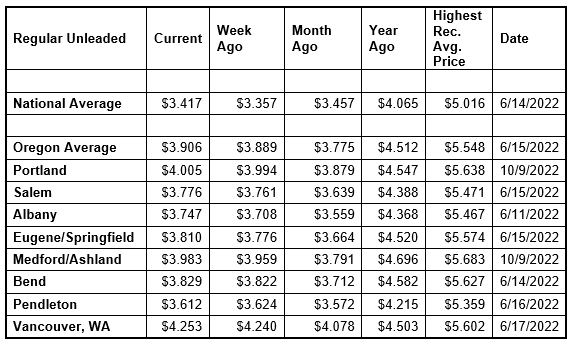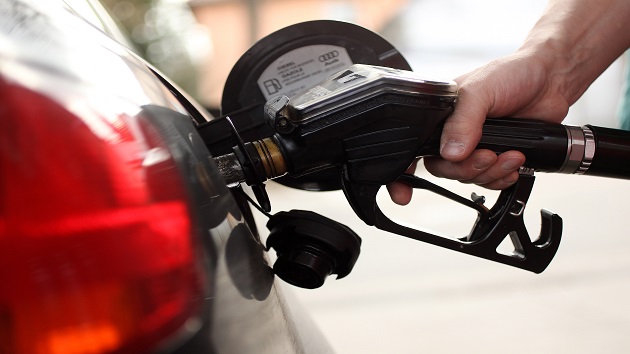Gas prices are rising across the country, mostly due to the seasonal switch to summer-blend gas. This blend is designed to lower emissions during warmer weather and is more expensive to produce. Increased demand for gas is also putting upward pressure on prices. For the week, the national average for regular unleaded jumps six cents to $3.42. The Oregon average ticks up two cents to $3.91.

“The switch to summer blend usually adds about five to 10 cents a gallon to the price of gasoline,” says Marie Dodds, public affairs director for AAA Oregon/Idaho. California’s deadline to switch to summer-blend gas is April 1, while the federally mandated date for summer-blend gas is May 1. So the West Coast often sees the seasonal increases earlier than other parts of the country.”
More info on summer- and winter-blend gasoline can be found at the EPA website.
Crude oil is trading around $78 today compared to $77 a week ago. In February, West Texas Intermediate ranged between about $73 and $80 per barrel. In January, WTI ranged between about $73 and $82 bbl. and was $119 a year ago as the Russian invasion of Ukraine had started. Crude reached recent highs of $123.70 on March 8, 2022, and $122.11 per barrel on June 8, 2022. The all-time high for WTI crude oil is $147.27 in July 2008.
Crude prices tend to increase in response to positive economic news, as growing, thriving economies tend to consume more oil. Crude prices also climb when geo-political events have the potential to disrupt supply. Crude prices rose dramatically leading up to and in the first few months of Russia’s invasion of Ukraine, and gas prices also skyrocketed. Russia is one of the world’s top oil producers and its involvement in a war causes market volatility, and sanctions imposed on Russia by the U.S. and other western nations resulted in tighter global oil supplies. Oil supplies were already tight around the world as demand for oil increased as pandemic restrictions eased.
Crude oil is the main ingredient in gasoline and diesel, so pump prices are impacted by crude prices on the global markets. On average, about 56% of what we pay for in a gallon of gasoline is for the price of crude oil, 20% is refining, 11% distribution and marketing, and 14% are taxes, according to the U.S. Energy Information Administration.
Demand for gasoline in the U.S. jumped from 8.91 million to 9.11 million b/d for the week ending February 24. This compares to 8.74 million b/d a year ago. Meanwhile, total domestic gasoline stocks decreased by nearly 1 million bbl to 239.2 million bbl. The increase in gas demand, amid tighter supplies, has contributed to rising pump prices. If demand continues to grow, drivers will likely continue to see pump prices increase.
Quick stats
Oregon is one of 38 states and the District of Columbia with a week-over-week increase. Ohio (+22 cents) and Michigan (+22 cents) have the largest gains. Colorado (-7 cents) has the largest weekly decline.
For the first time in 14 weeks, California ($4.91) bumps Hawaii ($4.86) as the state with the most expensive gas in the nation. Nevada ($4.33) is third, Washington ($4.24) is fourth. These are the only four states with averages at or above $4 a gallon. This week 44 states and the District of Columbia have averages in the $3-range. Two states have averages in the $2-range: Mississippi ($2.96) and Texas ($2.97).
The cheapest gas in the nation is in Mississippi ($2.96). For the 112th week in a row, no state has an average below $2 a gallon.
The difference between the most expensive and least expensive states is $1.95 this week compared to $1.97 last week.
Oregon is one of 14 states with higher prices now than a month ago. The national average is four cents less and the Oregon average is 13 cents more than a month ago. This is the sixth-largest monthly increase in the country. California (+30 cents) and Nevada (+28 cents) have the largest monthly gains. Florida (-20 cents) and Virginia (-16 cents) have the largest monthly declines.
Oregon is one of 48 states and the District of Columbia with lower prices now than a year ago. The national average is 65 cents less and the Oregon average is 61 cents less than a year ago. Connecticut (-$1.00) has the largest yearly drop. Colorado (+23 cents) and Hawaii (+23 cents) have the biggest year-over-year declines. A year ago, pump prices were rising rapidly after the start of the Russian invasion of Ukraine.







